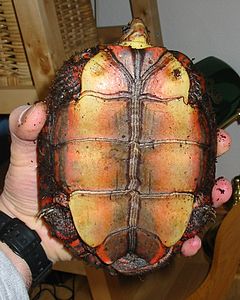en
names in breadcrumbs


Some subspecies of Rhinoclemmys pulcherrima are very bright and colorful. R.p. manni has red and yellow ocelli on the carapace and head; this pattern may resemble the colors of the venomous coral snakes and thus serve to frighten predators. (Ernst and Barbour, 1989)
The scientific name was formerly spelled Rhinoclemys and formerly called Callopsis. (Obst, 1988)
Collecting (for food and the pet trade) and deforestation are the major threats to this turtle. Their natural predators include crocodiles, birds, and mammals. (IUCN, 1998)
US Federal List: no special status
CITES: no special status
This species is harmless to human interests.
Rhinoclemmys pulcherrima may serve as a biological control of agricultural (especially insect) pests (IUCN, 1998). Because Rhinoclemmys pulcherrima is so attractive (especially R. p. manni) it is often exploited for the pet trade. Unfortunately this species seldom does well in captivity and usually dies within the first year.
Rhinoclemmys pulcherrima is omnivorous. It feeds on wildflowers, grasses, fruit (guavas, mangos, oranges), insects, worms, and fish. (Ernst and Barbour, 1989) Even though they may spend some of their time soaking in ponds or other bodies of water, they normally eat on land. (McCormick, 1998)
Rhinoclemmys pulcherrima is comprised of four subspecies which collectively range from Sonora, Mexico to Costa Rica. They are the only turtles of the subfamily Batagurinae to occur in the New World (Ernst and Barbour, 1989). Note: Some herpetologists consider this group of turtles as a separate family, the Bataguridae.
Biogeographic Regions: nearctic (Native ); neotropical (Native )
Rhinoclemmys pulcherrima is a terrestrial lowland species, primarily an inhabitant of scrub lands and moist woodlands, but also occurs in gallery forest close to streams. The red terrapin seems, at least in Costa Rica and Nicaragua, to prefer moist situations, and has been observed wading and swimming in streams and rain pools, especially during the dry season. (Ernst and Barbour, 1989)
Terrestrial Biomes: scrub forest
Average lifespan
Status: captivity: 20.4 years.
Rhinoclemmys pulcherrima is an attractive species with thin red lines on the face and extensive areas of red and black vermiculations on the limbs, thighs, and tail as well as on the ventral parts of the marginal scutes and near the midline of the plastron. It has a small head with finely serrated jaw edges. (Pritchard, 1979) The carapace is light brown with a ridge down the middle and moderate sculpturing on the scutes. The plastron is yellowish with red markings visible on the marginals. The shell is somewhat elongated. (McCormick, 1998) Males reach a carapace length of 18 cm and have a concave plastron and a longer thicker tail, with the vent beyond the carapacial margin. Females are larger (up to 20 cm CL) with a flat plastron that is slightly upturned anteriorly, and a shorter tail with the vent beneath the carapace edge. The carapace is flatter and broader in the northern parts of the range, and domed and narrower southward. (Ernst and Barbour, 1989) One subspecies, Rhinoclemmys p. rogerbarbouri has an interesting carapace that is somewhat wedge-shaped dorsally and with straight, posteriorly diverging sides, and upturned marginal edges in some specimens. This forms a "gutter" that may serve to direct rain water towards the mouth, as has been observed with some species of tortoises. (Pritchard, 1979)
Other Physical Features: ectothermic ; bilateral symmetry
Rhinoclemmys pulcherrima lays several clutches of three to five eggs from May to December. Eggs may be buried in soil or leaf litter. The eggs are elongated and brittle-shelled. (IUCN, 1998) The eggs measure 24-32 mm x 37-52 mm. Hatchlings measure from 35 to 50 mm in carapace length. (Ernst and Barbour, 1989) This species has temperature-dependent sex determination (TSD) Pattern Ia (Ewert and Nelson, 1991). Within the temperature range suitable for incubation, eggs incubated at cooler temperatures produce mostly males, while warmer eggs produce females. At 24C to 27C all males will form. When eggs are incubated at 30C only 25% of hatchlings will be males, and above 30C only females hatch out. (Ewert and Nelson, 1991)
Key Reproductive Features: gonochoric/gonochoristic/dioecious (sexes separate)
The ornate or painted wood turtle[2] (Rhinoclemmys pulcherrima) is one of nine turtle species of the genus Rhinoclemmys of the family Geoemydidae. There are four recognized subspecies.[3]

Painted wood turtles can grow to a maximum length of 20 cm. It has a dome-shaped carapace and the plastron has a continuous ventral line. It has red stripes on its body and it has webbed feet.
It is found in Mexico (from Sonora southwards) and Central America, as far south as Costa Rica.
Painted wood turtles live in rainforests, shallow rivers and bushes. Although they are mostly terrestrial, they can occasionally be found in shallow water.
The painted wood turtle feeds on fruit, insects, and worms. Their diet should consist of 60% leafy greens, 30% protein, and 20% fruits and vegetables. Along with a varied diet, they require additional calcium to insure healthy shell growth. Unlike aquatic turtles, the painted wood turtle doesn't require water in order to swallow its food.
Painted wood turtles are oviparous. Females lay 3-5 eggs at a time. Eggs at low temperatures can be dormant early stages, and can sleep for some time at low temperatures, when the temperature returns to normal incubation can proceed.
Painted wood turtles can be kept as pets, and it has long been imported into the various parts of Asia, such as Japan, Taiwan and China. The nominate subspecies is the most common subspecies kept in captivity. They will eat commercial turtle food, and will also eat plant matter.
The ornate or painted wood turtle (Rhinoclemmys pulcherrima) is one of nine turtle species of the genus Rhinoclemmys of the family Geoemydidae. There are four recognized subspecies.